Looking to add Wi-Fi 7 to a Windows computer? The NETGEAR A9000 Nighthawk BE6500 WiFi 7 USB 3.0 Adapter is an easy answer.
In my real-world usage, this dongle offers sustained Wi-Fi rates up to over 1.7Gbps (on the 5GHz or 6GHz band), depending on the distance, making it a clear upgrade to the previous Wi-Fi 6E model, the Wi-Fi 6E A8000. Of course, you need a Wi-Fi 7 router (or access point) to get the best out of it.
Here’s the bottom line: The NETGEAR A9000 is not a must-have, but if you want your current relatively dated Windows computer to have a Wi-Fi connection (almost) as fast as the latest one, it’s a worthy upgrade. Check it out!
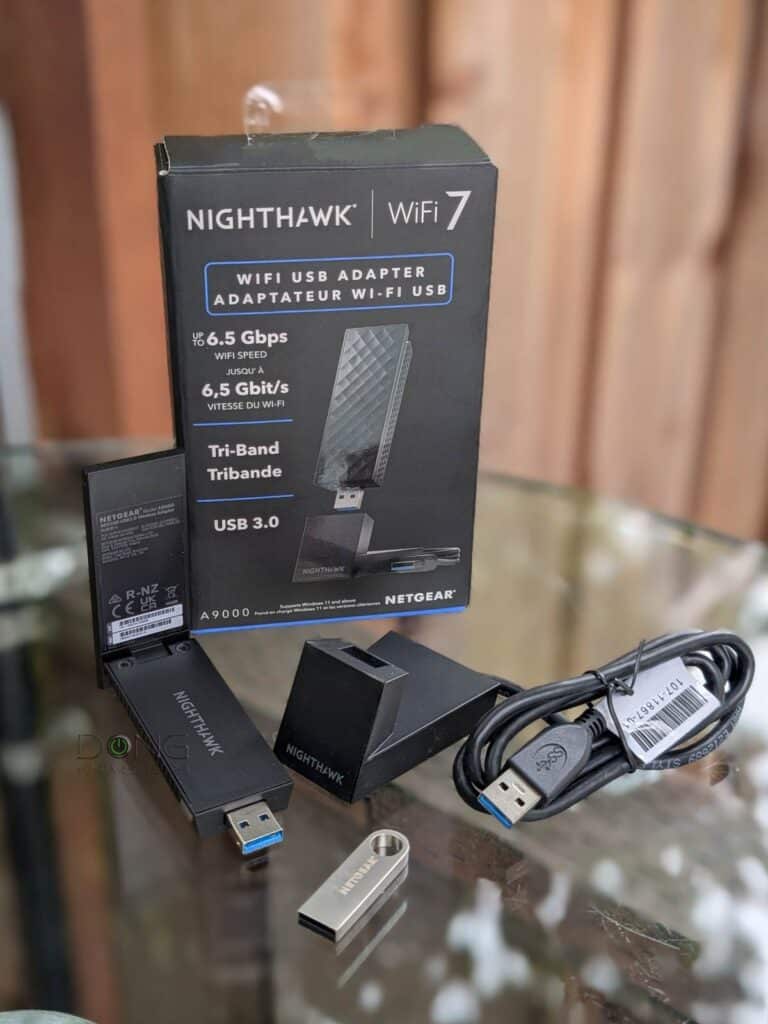
NETGEAR Nighthawk A9000 (vs. Nighthawk A8000): An easy upgrade to entry-level Wi-Fi 7 performance
In more ways than one, the Nighthawk A9000 is the Wi-Fi 7 version of the previous Wi-F 6E Nighthawk A8000.
The two share the same physical shape, size, and weight, and both have the low-end configuration of their respective Wi-Fi standard. Specifically, the A8000 doesn’t feature Wi-Fi 6’s 160MHz channel width, and the new A9000 doesn’t support Wi-Fi 7’s new 240MHz or 320MHz channels, either. And both use USB 3.1 Gen 1 (a.k.a. USB 3.0) via the old-school USB-A connector—you’ll need an adapter if your computer has only USB-C ports.
While the lack of native USB-C support can be a downer, it makes sense since computers with only USB-C ports often already come with built-in Wi-Fi. So, this A9000 is made for computers that are relatively old, preferably a desktop, considering its bulky design.
What doesn’t make sense, however, is what NETGEAR claims on the A9000’s retail box, suggesting the adapter could offer up to 6.5Gbps Wi-Fi speed, which is untrue on so many levels—but true to form in the vendor’s marketing practice—because:
- The A9000 uses USB 3.0 to connect to a computer. USB 3.0 has a maximum theoretical speed of 5Gbps.
- Wi-Fi operates on a single band at a time, so on paper, you’ll get up to 2882Mbps out of the 5GHz or 6GHz—Wi-Fi 7’s MLO generally doesn’t increase connection speed on the client side.
- The real-world performance of both Wi-Fi and USB 3.0 is significantly lower than their theoretical speeds due to overhead and interference.
That said, make sure you tame your expectations when getting this adapter. The combo of low-end Wi-Fi 7 and USB 3.0 means it can deliver Gig+ real-world performance at best, which proved to be the case in my testing—more in the performance section below.
Tip
Gig+, or Gig Plus, denotes a speed grade between 1Gbps and 2Gbps. So, it’s 1.5Gbps, give or take a couple of hundred megabits per second, and it’s not speedy enough to qualify as Multi-Gig Ethernet or multi-Gigabit. Intel coined the term to describe its Wi-Fi 6E client chips, the AX210 and AX211, in terms of their real-world speeds.
Gig+ primarily applies to sustained Wi-Fi 6 or Wi-Fi 7 speeds via a 2×2 at 160MHz connection, or to broadband internet speeds.
Gig+ is plenty fast and a real upgrade to the A8000, which sustained at around 850Mbps at best. The table below shows the hardware specs of the two compared to the standard Intel BE200 Wi-Fi 7 chip used inside many computers.


NETGEAR Nighthawk A9000 vs. Nighthawk A8000 vs. Intel BE200: Hardware specifications
 |  | 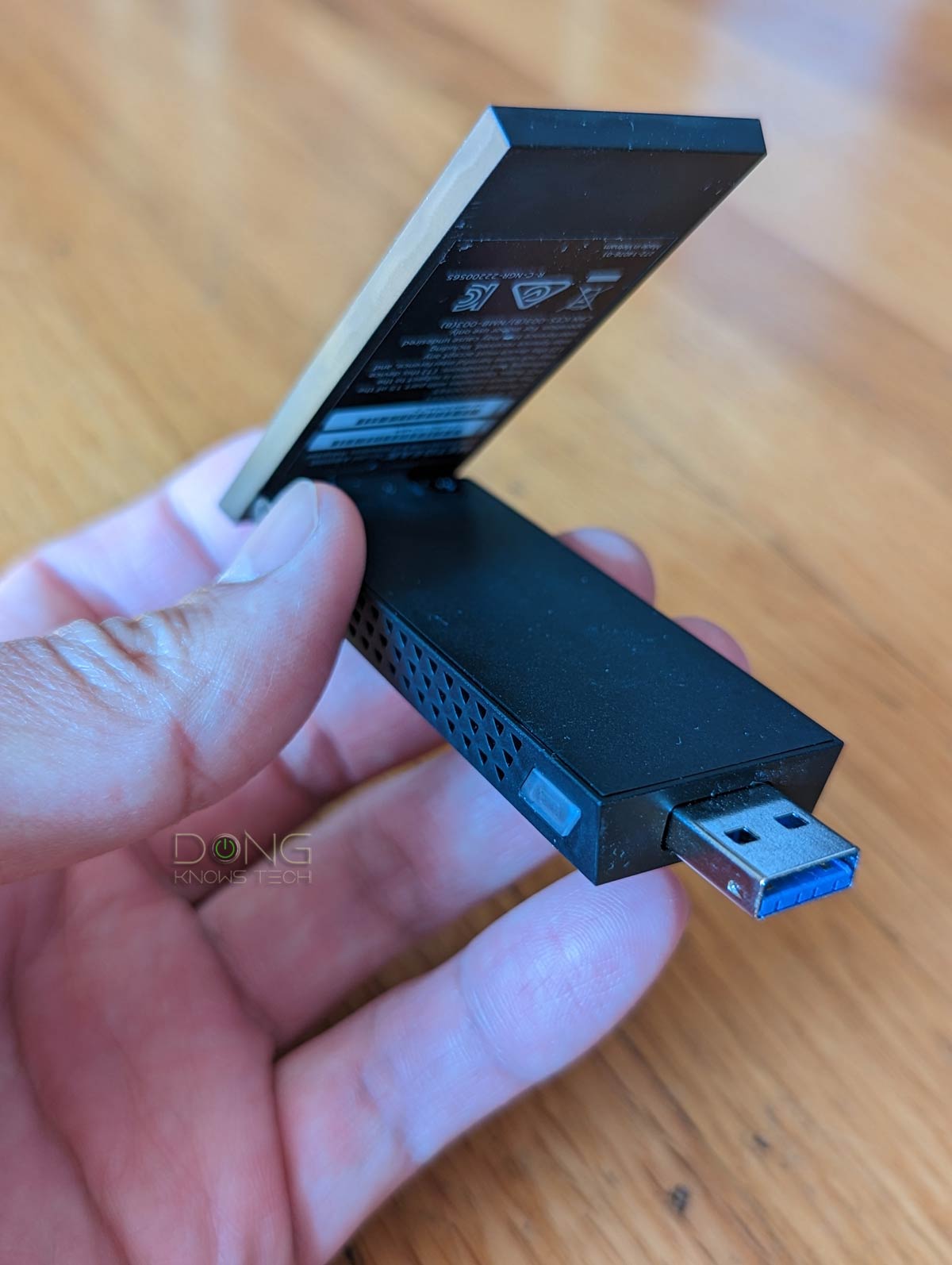 | |
|---|---|---|---|
| Name | Intel BE200 Wi-Fi 7 Adapter | NETGEAR A9000 Nighthawk WiFi 7 USB 3.0 Adapter | NETGEAR Nighthawk AXE3000 WiFi 6E USB 3.0 Adapter |
| Model | BE200 | Nighthawk A9000 | Nighthawk A8000 |
| Dimensions | M.2 2230 (22 x 30 x 2.4 mm), M.2 1216 (12 x 16 x 1.7 mm) | Adapter: 3.66 x 1.24 x 0.57 in (93.0 x 31.4 x 14.45 mm) Cradle: 2.49 x 1.76 x 1.39 in (63.14 x 44.67 x 35.19 mm) | |
| Weight | ≈0.15 g | Adapter: 0.99 oz (28 g) Cradle: 3.17 oz (90 g) | |
| Wi-Fi Bandwidth (theoretical) | Tri-band BE9500 | Tri-band BE6500 | Tri-band AXE3000 |
| 2.4GHz Band (channel width) | 2×2 BE: Up to 688Mbps (20/40MHz) | 2×2 AX: Up to 600Mbps (20/40MHz) | |
| 5GHz Band (channel width) | 2×2 BE: Up to 2882Mbps (20/40/80/160MHz) | 2×2 AX: Up to 1200Mbps (20/40/80MHz) | |
| 6GHz Band (channel width) | 2×2 BE: Up to 5763Mbps (20/40/80/160/320MHz) | 2×2 BE: Up to 2882Mbps (20/40/80/160MHz) | 2×2 AXE: Up to 1200Mbps (20/40/80MHz) |
| Best Theoretical Wi-Fi Speed | 5763Mbps | 2882Mbps | 1200Mbps |
| Security Support | WPA, WPA2, WPA3 | WPA, WPA2, WPA3 | |
| Bluetooth | 5.4 | None | |
| Interface | M.2 | USB 3.2. Gen 1 (5Gbps) USB 2.0 (reduced performance) | |
| Hardware Required | M.2 slot, PCIe adapter | USB-A port | |
| Platform Support | Win 11: 2.4GHz, 5Ghz, 6GHz (with Wi-Fi 7 features) Win 10: 2.4GHz, 5GHz | Win 11: 2.4GHz, 5Ghz, 6GHz Win 10: 2.4GHz, 5GHz | |
| Driver Version (used for testing) | 23.60.1.2 | 20.1.6 | 1.0.0.108 |
| US Launch Price (Check street prices!) | $20-$60 | $99.99 | |
A typical USB dongle
Out of the box, the NETGEAR A9000 comes with the cradle designed for a desktop computer, which is essentially a USB extension cord with a base. You can skip it and plug the adapter directly into a computer, provided there’s space for it on the computer itself—as a USB adapter, it’s pretty bulky.
Like the A8000, the A9000 comes with an external antenna that folds on its body. You extend it up to 170 degrees outward to improve the reception.
In my trial, the adapter is not natively supported by Windows 11. To use it, you first need to install the software driver. For that, NETGEAR includes a tiny 128MB thumb drive that contains the software. Alternatively, you can download the latest version from Netgear’s website.

Once the drive has been installed, the A9000 works as plug-and-play. You can install the software on different computers and move the adapter between them if you don’t want to buy one for each.
Other than USB 3.0, the adapter works with all USB ports I tried it with, including USB 2.0 ports, but in this case at much lower speed—USB 2.0 maxes out at 480Mbps.
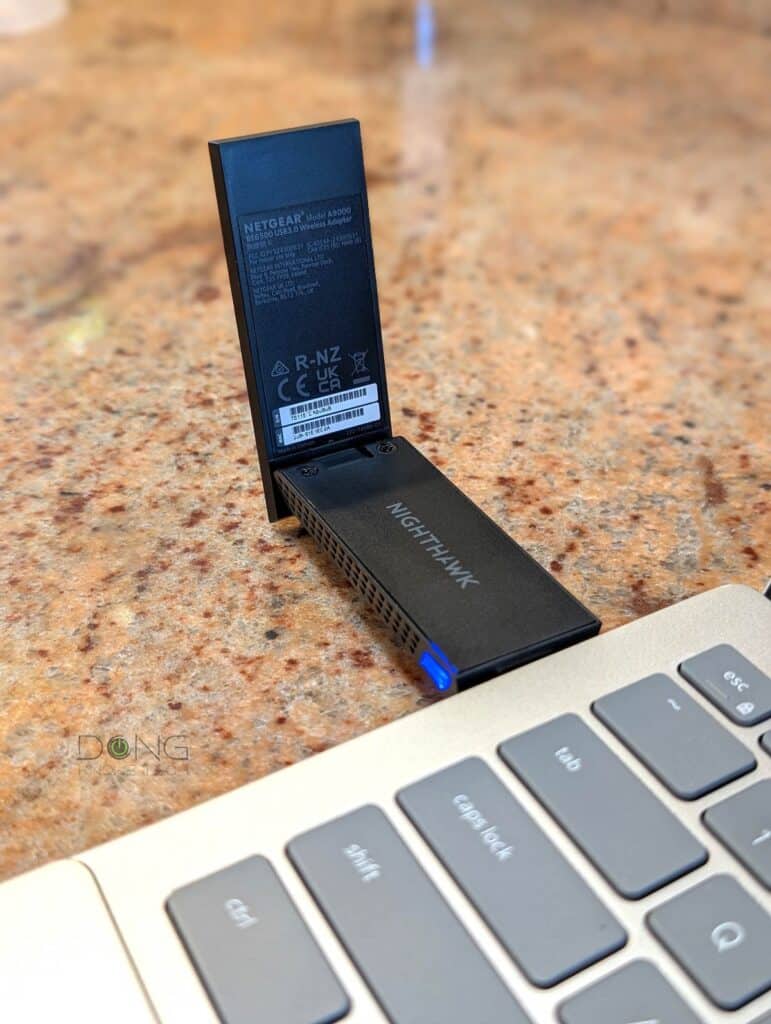
NETGEAR Nighthawk A9000: Excellent Gig+ performance
For an entry-level Wi-Fi 7 adapter, the Nighthawk A9000 performed well in my trial.
The adapter delivers excellent real-world rates per its specs—clearly much lower than the impossible 6500Mbps as claimed by NETGEAR—but plenty fast. It also supports MLO, which showed slightly better speeds.
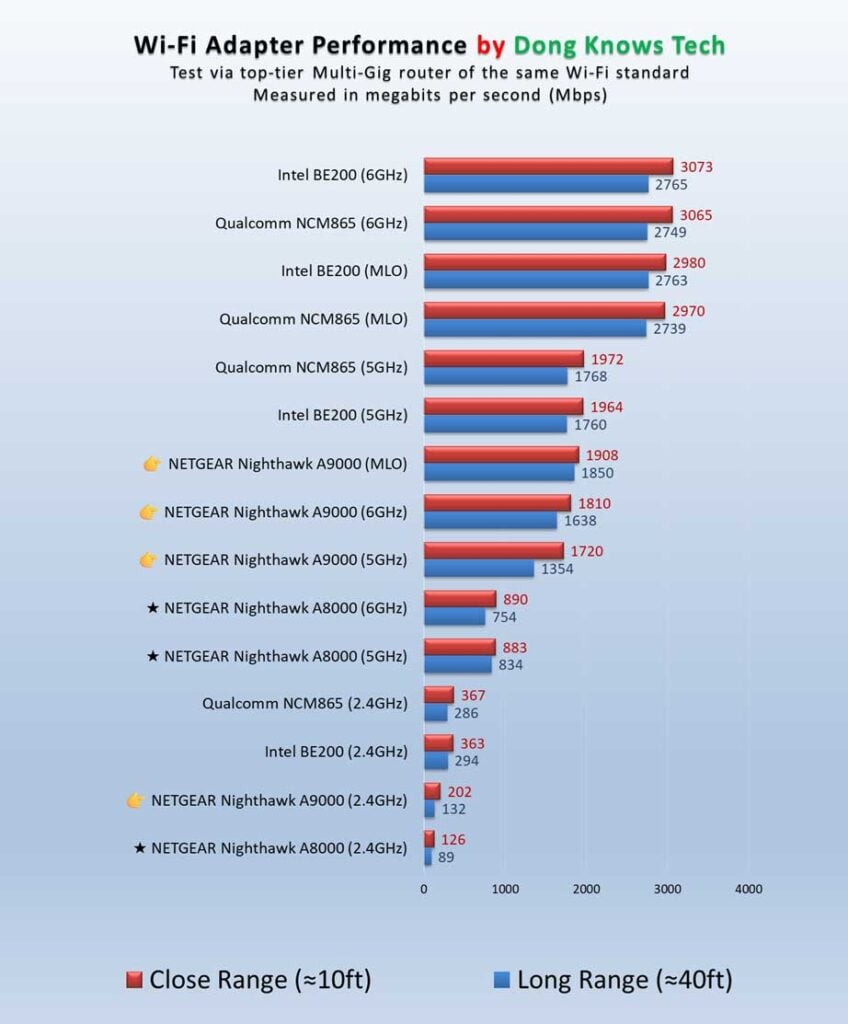
What’s more, the A9000 showed slight signal degradation over range. Its performance remains consistent within a 40-foot radius with a line of sight from the router.
Like the case of the A8000 and other USB Wi-Fi adapters I’ve used, the Nighthawk A9000 remained cool even after a long period of heavy loads, which is always a good thing.
NETGEAR A9000 Wi-Fi 7 USB Adapter's Rating

Pros
Quickly adds Wi-Fi 7 to a Windows computer
Fast and reliable Gig+ real-world performance
Software driver included
Cons
Only works with Windows (for now)
No 240MHz or wider channel support, no USB-C adapter included
A bit bulky
Conclusion
The NETGEAR A8000 Nighthawk BE6500 Wi-Fi 7 USB 3.0 Adapter is an easy and sure way to add Wi-Fi 7 to a Windows computer with a USB-A port. If you have upgraded that dated machine to Windows 11, consider this adapter today!


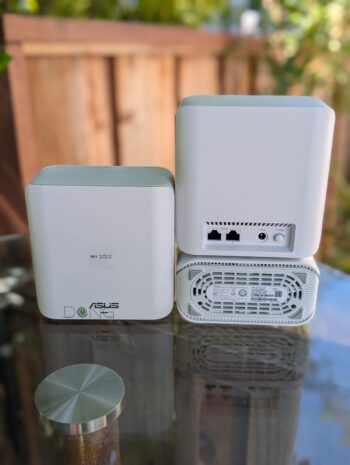
Comments are subject to approval, redaction, or removal. You're in the no-nonsense zone and that applies BOTH ways.
It's generally faster to get answers via site/page search. Your question/comment is one of many Dong Knows Tech receives daily.
Thank you!
(•) If you have subscription-related issues or represent a company/product mentioned here, please use the contact page or a PR channel.